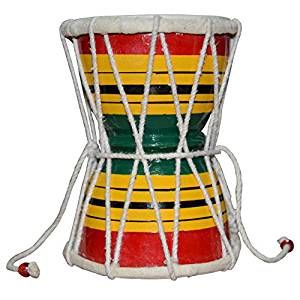
Shiva Damru
Get Price Quote
120 Piece (MOQ)

Musical Damru
Get Price Quote
Backed by a team of deft professionals, it has become easy for us to furnish divisive demands of the buyers and that too within shortest time possible. Courtesy a state-of-the-art warehousing unit and an ultramodern inventory control system, we take care of product storage related work with ease. Our warehouse and system empowers us to maintain year round products' availability. Features Finest wood selection Finely lacquered & polished Immersive sound quality
Best Deals from Damroo

Musical Damroo
40 Per Piece

Damru
Get Price Quote
500 Piece (MOQ)
We are offering damru a beautiful range of baby damru lace is offered by us to fulfill the diversified demands of our esteemed clients. It is an indian traditional percussion instrument. The baby damru is known as a power drum, and when played tends to bring spiritual energy. It is especially associated with the hindu deity shiva.

damroo
Get Price Quote
damroo

Damru
Get Price Quote
Get in touch with us, if you are looking for Wholesale Damru at the best market rate. Our company is recognized as one of the reliable Manufacturers, Exporters and Suppliers of Damru. It is intricately carved and precisely designed by our skilled artisans using advanced tools and sophisticated technology. This Musical Instrument is available in different sizes, designs and specifications meeting the diverse requirement of buyers. History : Damru Damaru is a percussion musical instrument of India with a distinct religious significance. Just like the Veena of Goddess Saraswati and the flute of Lord Krishna, the Damaru is the drum of the divine dancer, Lord Shiva. Indeed, the elemental vibration of creation was the sound of the Damaru or Dhakka of Lord Shiva. From this originated also all the sounds of speech and music. Historically, however, the Damaru and its variations such as the Dhakka and the Dimdima are found mentioned in Amarakosa (fifth century AD), Mahasutasoma, Jataka Astadhyayi (seventh century AD) and so on. Old Tamil Literature also has references to Damarukam. Some of the names by which this class goes under are Damru, Dambru Kudukuduppai, Budbudke and Budbudukalu, the last two in south Indian languages. Though it is heard rarely in the more developed folk music, it is a companion of wandering minstrels, soothsayers and monkey-men. Details : Usually the length is of 10 cm, the diameter varying to suit the Lengti. The height of the Damaru ranges from a few inches to a little over a foot. The shell is made of wood or brass: in unusual cases, as in the Lamaic, the body is of two human skulls fixed hind to hind. The drum faces of leather are attached to metal or bamboo rings and mutually connected by cotton or hemp threads, which are tightened with another thread going round them at the region of the waist. Two cotton strings knotted at the free ends are tied at the constricted part of the body. The Damaru is played with one hand. The strikers are typically beads fastened to the ends of leather cords around the waist of the Damaru. Knots in the leather can also be used as strikers. The player holds the instrument at the waist and jerks it. This action makes the knots strike or clap the faces, producing the sound. This is why this class of membranophones is often called the clapper drums. By pressing or loosening the braces, different rhythmic and pitch effects are obtained.